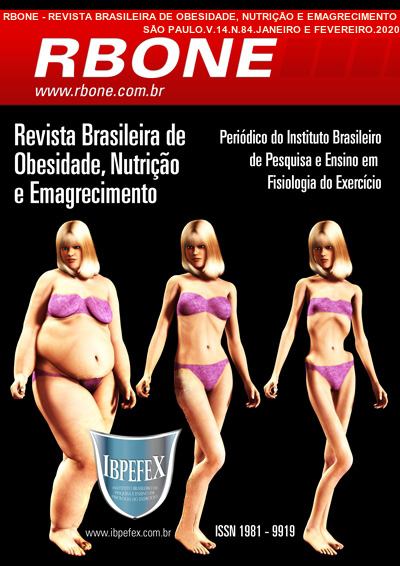Síndrome metabólico y climatérico: impacto de la intervención nutricional
Resumen
Introducción y objetivos: El síndrome metabólico (SM) es un trastorno complejo caracterizado por la coexistencia de enfermedades crónicas que constituyen factores de riesgo para el desarrollo de enfermedades cardiovasculares. Materiales y métodos: Estudio de intervención antes y después, se seleccionaron mujeres (n=19) con un nivel de Hormona Folículo Estimulante (FSH) superior a 40 mUI/ml, compatible con el síndrome climatérico, o con última menstruación (DUM) hace por lo menos doce meses. Para el diagnóstico de SM se siguieron los parámetros establecidos por la Federación Internacional de Diabetes (IDF), en los que la obesidad central es el principal criterio diagnóstico. La orientación de la dietoterapia se realizó en consultas individuales, con recomendaciones adaptadas a cada paciente. Como parámetro de seguimiento de la evolución del estado nutricional se utilizó el perímetro de cintura. Las mediciones se realizaron en dos consultas, realizadas con un intervalo promedio de 75 días entre la primera y la segunda evaluación. Resultados: La adiposidad central fue el cambio estadísticamente más significativo (p<0,0001). Discusión: Entre las variables estudiadas, hubo una reducción significativa en el peso corporal (PC), la circunferencia de la cintura (CC), el índice de masa corporal (IMC) y la circunferencia del cuello (NC). La intervención nutricional mostró que la reeducación alimentaria puede ser catalogada como una de las bases para el control, y posible reversión, en el contexto del Síndrome Metabólico. La medición de la CC hace posible un diagnóstico precoz con una intervención rápida y adecuada. Conclusión: A la vista de los resultados alcanzados en el presente estudio, la intervención nutricional demostró ser eficaz en la reducción de la adiposidad central y la pérdida de peso.
Citas
-Barroso, T.A.; Marins, L.B.; Alves, R.; Gonçalves, A.C.S.; Barroso, S.G.; Rocha, G.S. Association of Central Obesity with The Incidence of Cardiovascular Diseases and Risk Factors. International Journal of Cardiovascular Sciences. Vol. 30. Num. 5. 2017. p. 416-424.
-Busnello, F.M.; Bodanese, L.C.; Pellanda, L.C.; Santos, Z.E.A. Intervenção Nutricional e o Impacto na Adesão ao Tratamento em Pacientes com Síndrome. Arq. Bras. Cardiol. Vol. 97. Num. 3. 2011.
-Gadelha, A.B.; Myers, J.; Moreira, S.; Dutra, M.T.; Safons, M. P.; Lima, R.M. Comparison of adiposity indices and cut-off values in the prediction of metabolic syndrome in postmenopausal women. Diabetes & Metabolic Syndrome: Clinical Reserch & Reviews. Vol. 10. Num. 3. 2016. p. 143-148.
-Figueiredo Neto, J.A.; Figuerêdo, E.D.; Barbosa, J. B.; Barbosa, F.F.; Costa, G.R.C.; Nina, V.J.S.; Nina, R.V.A.H. Síndrome Metabólica e Menopausa: Estudo Transversal em Ambulatório de Ginecologia. Revista Brasileira de Cardiologia. Vol. 95. Num. 3. 2010. p. 339-345.
-Gallon, C.W.; Wender, M.C.O. Estado Nutricional e Qualidade de Vida da Mulher Climatérica. Revista Brasileira de Ginecologia e Obstetrícia. Rio de Janeiro. 2012. Vol. 34. Num. 4. 2012.
-Instituto Brasileiro de Geografia e Estatística. Projeção 2018. Disponível em: https://www.ibge.gov.br/apps/populacao/projecao/Acesso em 16/05/2019.
-International Diabetes Federation. Consensus Statements. IDF Consensus Word wide Definition of the Metabolic Syndrome. 2006. Disponível em:https://www.idf.org/e-library/consensus-statements/60-idfconsensus-worldwide-definitionof-the-metabolic-syndrome.html. Acesso em 06/04/2019.
-Lima, C.G.; Basile, L.G.; Silveira, J.Q.; Vieira, P.M.V; Oliveira, R.M. Circunferência da Cintura ou Abdominal? Uma RevisãoCrítica dos Referenciais Metodológicos. Revista Simbio-Logias. Vol. 4. Num. 6. 2011. p. 108-131.
-Lorenzi, D.R.S.; Danelon, C.; Saciloto, B.; Padilha Junior, I. Fatores indicadores da sintomatologia climatérica. Rev Bras Ginecol Obstet. Rio de Janeiro. Vol. 27. Num.1. 2005. p. 12-19.
-Ministério da Saúde. Orientações para a Coleta e Análise de Dados Antropométricos em Serviços de Saúde. Norma Técnica do Sistema de Vigilância Alimentar e Nutricional. SISVAN. Série G. Estatística e Informação em Saúde. Brasília. 2011. p. 34-37.
-Oliveira, C.; Brauna, C.; Camlofski, L.; Kuhl, A.M.; Melhem, A.R.F.; Schiessel, D.L.; Cavagnari, M.A.V.; Bennemann, G.D. Intervenção Nutricional: Reeducação Alimentar Alliada à Atividade Física em Mulheres com Síndrome Metabólica. Revista Brasileira de Obesidade, Nutrição e Emagrecimento. São Paulo. Vol. 13. Num. 78. 2019. p. 267-274.
-Organização Mundial da Saúde. Relatório Mundial de Envelhecimento e Saúde. 2015. Disponível em: https://sbgg.org.br/wp-content/uploads/2015/10/OMS-ENVELHECIMENTO-2015-port.pdf Acesso em 17/05/2019. 13-Schmitt, A.C.B. Prevalência da Síndrome Metabólica e Fatores Associados na Transição e após a menopausa. Tese de Doutorado. Faculdade de Saúde Pública. Universidade de São Paulo-USP. São Paulo. 2009.14-Silva, M.L.N.; Marucci, M.F.N.; Roediger, M.A. Tratado de Nutrição em Gerontologia. Manole. 2016. p. 172.15-Sociedade Brasileira de Cardiologia; Sociedade Brasileira de Endocrinologia e Metabologia; Sociedade Brasileira de Diabetes; Associação Brasileira para Estudos da Obesidade. I Diretriz Brasileira de Diagnóstico e Tratamento da Síndrome Metabólica. Arquivos Brasileiros de Cardiologia. Vol. 84. Suplemento I. 2005. p. 3-28.
Derechos de autor 2020 Gisela de Camargo Cunha Arnaud Fonseca, Camila Dias Ribeiro Rosado, Raquel Senna Telhado, Claudia Cardoso Netto, Lizanka Marinheiro

Esta obra está bajo licencia internacional Creative Commons Reconocimiento-NoComercial 4.0.
Los autores que publican en esta revista aceptan los siguientes términos:
Los autores conservan los derechos de autor y otorgan a la revista el derecho de primera publicación, con el trabajo licenciado simultáneamente bajo una licencia de atribución Creative Commons BY-NC que permite compartir el trabajo con reconocimiento de la autoría del trabajo y publicación inicial en esta revista.
Los autores están autorizados a asumir contratos adicionales por separado, para distribución no exclusiva de la versión del trabajo publicado en esta revista (por ejemplo, para publicar en un repositorio institucional o como capítulo de libro), con reconocimiento de autoría y publicación inicial en esta revista. .
Se permite y anima a los autores a publicar y distribuir su trabajo en línea (por ejemplo, en repositorios institucionales o en su página personal) en cualquier momento antes o durante el proceso editorial, ya que esto puede generar cambios productivos, así como aumentar el impacto y la citación de lo publicado. trabajo (ver El efecto del acceso abierto).






